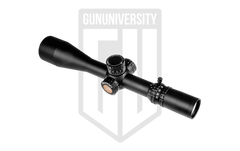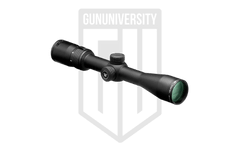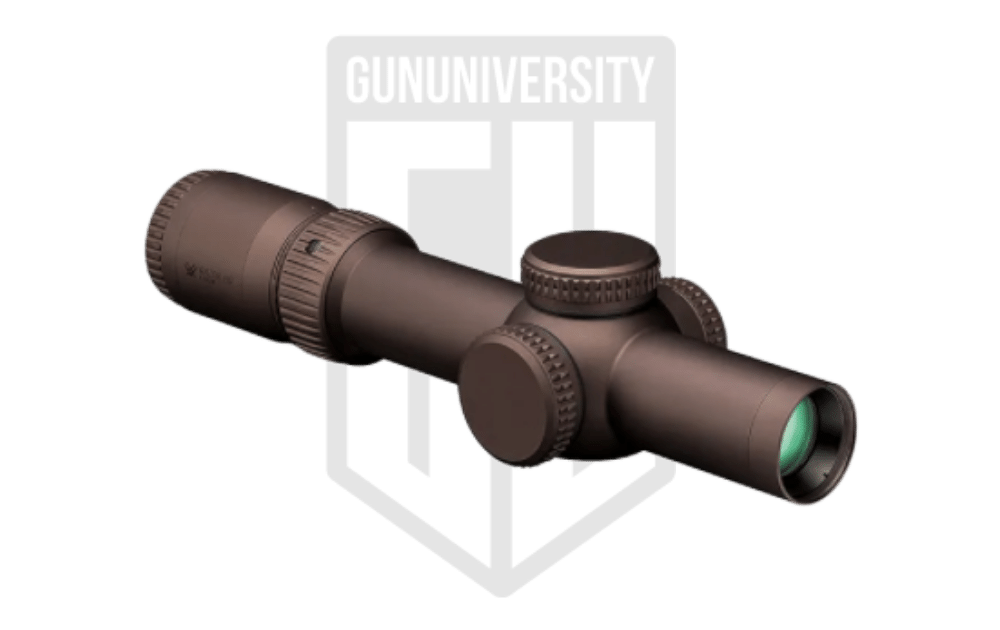FFP vs SFP – Everything You Need to Know
If you’re shopping for an optic, you’ve likely realized that there is a lot to consider.
I mean, you have to think about magnification settings, reticles, size and weight, and the topic of this article, the focal plane of the optic.
Focal planes of a scope are often misunderstood. And, even when you try to research the differences, you might be left more confused than when you started. Heck, you may not have even considered a scope’s focal plane until now – don’t worry!
Let’s try to solve that here and break down the two focal plane options so that they’re easy to understand.
The two focal plans options for a scope are:

A scope is a FFP or SFP scope depending on where the erector assembly is placed within the scope in relation to the lenses. If the erector assembly is located in the first focal plane of the scope, then it is a FFP scope. The same is true for the second focal plane.
Why does this matter?
Great question… let’s look at that first.
FFP SCOPES: When the magnification setting on a first focal plane scope is adjusted, both the reticle (crosshairs) AND the target image increase or decrease in size TOGETHER.

Note that in both the low magnification and high magnification views, the target measures 7 Mils tall. This is because the reticle changes size in proportion along with the target.
SFP SCOPES: When the magnification setting on a second focal plane scope is adjusted, ONLY the target image changes in size whereas the reticle (crosshairs) stays the same size.

Note that in both the low magnification and high magnification views, the reticle stays exactly the same size so the target measures different mil readings.
Before we get into why these differences matter, let me give you two quick tips:
- If you’re getting into long range precision rifle shooting and you have a reticle with graduated markings on it for hold-overs and wind-holds, get a FFP scope. It’ll cost more but it’ll be worth it.
- If you’re getting a scope for hunting and don’t need markings on your reticle as reference marks, consider getting a SFP scope. It will not only be less expensive, it will be easier to use in low-light hunting situations at lower magnification (the reticle will still be big enough to see).
Second Focal Plane scopes were available for many years before First Focal Plane scopes. Your dad’s old hunting rifle was surely a second focal plane scope.
You can get a lot more scope for the money with a SFP scope because it is more difficult and expensive for manufacturers to make FFP scopes. So, a SFP scope of the same price as a FFP scope is usually a nicer scope. To get the same quality in a FFP scope, expect to spend at least 20% more for a comparable scope.
So A FFP Scope is the Best?
Automatically it’s easy to assume that FFP optics are just better and SFP optics are silly and should just be tossed aside. But, that’s not a nuanced way to view things. Admittedly, first focal plane scopes have some serious advantages.
First, for long-range scopes, FFP is the way to go. If you want to shoot your 300 Winchester Magnum or even your 6.5 Creedmoor to its max range, then you need a First Focal Plane scope. Reticles with windage and distance holdovers are a must-have. When you begin shooting long-range, you’ll purchase a powerful optic, and then you might find yourself shooting at moderate ranges.

As a FFP scope, you can zoom in, see your target and still trust your holdovers. On the opposite side, sometimes it’s good to shrink a reticle for close-range use.
On the LPVO (Low Power Variable Optic) side, the lower settings allow you to clear up your lens and use the reticle easily in close quarters. Modern LPVOs will often have an illuminated center dot or segmented circle that’s rather large at higher magnification settings. At lower stages, the glowing reticle acts almost like a red dot. It’s eye-catching, easy to see, and easy to put on target.
Variable optics and LPVOs work best with the first focal plane when the magnification is on the high side, and the reticle offers a holdover system for bullet drop or wind calls. The downside tends to be the price point. FFP optics are a bit more expensive on average.
Where SFP Shines
First focal plane optics provide accurate reticles at any magnification, so why wouldn’t I want an FFP? Well, does your optic need ballistic holdovers? Are you going to be shooting at ranges where you’ll need to hold over and estimate for the wind? Plenty of hunters and rimfire shooters won’t need that kind of setup.
Lowered powered optics designed for recreationally shooting, for hunting, and similar tasks often have a simple crosshair setup, and that’s all you need for shooting at ranges from 0 to 300 yards with most centerfire rifle calibers. You’ll have no problems taking a whitetail with a 3-9X optic.
Beyond that, lower-powered LPVOs in the 1-4X and sometimes the 1-6X rating could benefit from being a second focal plane scope. This is especially true when the reticle is rather large and set up for those quick and accurate shots versus those precise long-range shots. Having a big reticle at lower powered magnification ratings is quite handy. Also, if you are shooting a lower-powered optic with a bullet drop compensating reticle, then you aren’t likely to use that reticle on a lower-powered setting, so maxing out isn’t an issue.
Also, these optics tend to be more affordable and more common. The downside to SFP optics is obviously the lack of attraction for long-range shooting and for using complicated reticles.
Favorite FFP Optics
 |
| Check Price | |
 |
| Check Price | |
 |
| Check Price |
My Favorite FFP Optics
Let us start of with my favorite First Focal Plane Optics and look at a brief review and price on each of these options.
Vortex Razor HD Gen 3 1-10X24 Review

This is not just my all-time favorite FFP optic, but it’s my favorite LPVO. The Razor HD Gen 3 1-10X builds successfully on the Gen 2 1-6X, which became a spec ops favorite LPVO. What’s really remarkable is that Vortex fits a 1-10X optic in the footprint of a 1-6X optic. It’s the same length as the 1-6X model and even weighs a bit less.
From the ground up, the reticle has been designed to take advantage of a first focal plane design. The center has a big circle and a small red dot that appears like a red dot at lower magnification settings. This red dot makes those close-range shots quick and possible.
Zoom in with the EBR-9 MOA reticle, and you have subtensions for windage, for bullet drop, and pyramid that combines the two. Vortex’s reticle is super handy and allows you to make shots at any distance. The magnification range is brilliant, the optic is well made and ready for duty use. It’s pricey but worth every penny.
Vortex Razor HD Gen 3 1-10X24 Deals
-
$2,499.99
-
$1,989.00
Primary Arms SLX 1-8X24 Review

Lots of FFP scopes are expensive, incredibly expensive, in the thousands of dollars. Yet, Primary Arms swings in once more to provide an affordable FFP option for shooters everywhere. The SLX 1-8X24 FFP gives you that first focal plane setup combined with the ACSS-Raptor reticle.
The Raptor reticle and 1-8X magnification range make a first focal plane setup a requirement. The reticle grows and shrinks and makes it much easier to use at both 1X and 8X. Making use of the bullet drop compensator and windage holdovers would be a real pain with an SFP optic.
When things get closer, the same could be said regarding the reticle for quick and accurate shots on target. The Primary Arms SLX 1-8X24 grants you a very capable and versatile optic well suited for a variety of uses.
Primary Arms SLX 1-8X24 Deals
-
$289.99
-
$469.99
3. Nightforce ATACR 7-35×56
Nightforce ATACR 7-35×56
Trusted by the military on multiple levels in multiple magnification ranges, the ATACR line is one of the most battle-proven scopes on the market.
Nightforce ATACR 7-35×56 F1 Review

Have you ever used a 3,600 dollar scope? I’ve been lucky enough to shoot beyond a thousand yards with a Nightforce ATACR and a very patient spotter coaching me into steel. The difference a high-quality optic makes is absurd. Some combinations of glass and aluminum just work well, and Nightforce and the ATACR series are some of the best.
The 7-35X range is an interesting magnification range and provides long-distance performance for those large caliber rifles. You can reach out, see the target, and then let a piece of lead fly at the target. The reticles wouldn’t work on any other setup other than an FFP scope. The ATACR’s reticle selection varies, but the complicated Horus Tremor3 or MIL-XT certainly requires an FFP scope.
These reticles allow for ultra-fine adjustments that ensure precision and accuracy at any magnification range. It’s invaluable and ensures you can take wind and bullet drop into account at any range and any magnification setting.
Nightforce ATACR 7-35×56 F1 Deals
-
$3,600.00
-
$3,600.00
Favorite SFP Optics
| Check Price | ||
 |
| Check Price | |
 |
| Check Price |
My Favorite SFP Optics
Now let’s have a look at my favorite Second Focal Plane optics options. Below we have my top three favorite SFP optics and we look at a short review of each and we find the best price.
Trijicon Accupoint 1-4X Review

Lots of people will quickly hit you with the tactical use, these optics should only be SFP. I always point those people to the Trijicon Accupoint 1-4X, specifically the TR24R. Why these specific models? Well, the triangular reticle that glows bright red grabs your eye. As an SFP optic, the triangle remains the same size throughout each magnification range.
At 1X, the red triangle is essentially a red dot. It’s easy to see, it’s fast to use on close-range targets, and it’s responsive. As you increase the magnification, the reticle remains the same size and still gives that quick encounter speed. That triangle reticle is simple and benefits greatly from the second focal plane setup.
The Accupoint sits happily on a light carbine and allows you to reach out to 300 yards with absolute ease. The Accupoint is a very underrated optic, and that’s likely due to Trijicon’s price point. Yet, it’s incredibly durable and very well made.
Trijicon Accupoint 1-4X Deals
-
$714.56
-
$748.99
Leupold VX-Freedom 3-9X40 Review

If you come to me asking what scope I should buy for my hunting rifle, I’m going to say the VX-Freedom 3-9X40 from Leupold. When it comes to finding a tough, clear, and easy-to-use scope for hunting that won’t empty your wallet, the VX-Freedom is the optic to go for. The VX-Freedom provides you with a versatile and handy magnification range for any hunting task.
The glass is crystal clear and makes those shots at sunrise and sunset capable and safe to do. The reticle is perfect for an SFP scope and makes it easy for quick shots at the 3X magnification setting, and out to 9X allows you to zoom in and spot an animal walking through the brush. As fall sets in and deer season starts, it can be tough to see a brown deer against brown foliage, and a clear optic helps.
The VX-Freedom offers you a wonderful optic at a wonderful price point. The optic is well made, extremely easy to use, and packed with a fantastic warranty. The VX-Freedom also comes in at a great price point.
Leupold VX-Freedom 3-9X40 Deals
-
$299.99
-
$299.99
Vortex Diamondback Rimfire 2-7X35mm Review

I can’t think of a good reason to attach a high-powered scope with an ultra-complicated reticle onto a 22 LR rifle. It seems silly, expensive, and kinda useless. With that in mind, my favorite rimfire dedicated optic is the Diamondback Rimfire 2-7X35mm. This second focal plane optic provides more than enough magnification for your Ruger 10/22, Mossberg Plinkster, or whatever other 22LR you might have.
The Diamondback Rimfire is also priced affordably, and it’s tough to beat. The little fella keeps things light and handy and the reticle is very simple and very handy. The center of the reticle is very fine and easy to use on small targets.
It’s simple and works at every magnification range due to its SFP design. The Diamondback rimfire is perfect for shooting shotgun hulls at 50 yards and soda cans at 15 yards. The little Diamondback Rimfire makes plinking a breeze and won’t kill you with its price point.
Vortex Diamondback Rimfire 2-7X35mm Deals
-
$239.99
-
$189.49
Staying in Focus
The focal plane is just one of the many considerations you have to make when it comes to choosing magnified optics. Yet, it’s a critical consideration you have to make when choosing your variable magnified optic. Hopefully, you can walk away from this article with a little bit better idea of what will work best for you and your rifle.
If you have any questions or comments, please share them below!
FFP vs SPF
We have found a great video brought to you by Vortex Optics on the topic of First Focal Plane vs Second Focal Plane which is a great summary to our article. Check it out below.
Recent Posts
December 20, 2025
December 15, 2025
December 15, 2025
December 12, 2025










Probably one of the best scopes ever made. End of story.
Exellent article, thank you! I have a situation I’d like your feedback on. I’m old, 74, and have to wear glasses and have a bit of cataracts. I have a 5.56 Sig MCX and I would like an optic that allows me to actually see a target out to 2-300 yards max. The tactical scopes 1×6 and 1×8 usually have only a 24mm objective lens. I’m not sure that will be bright enough at dusk/dawn low light conditions. I’m thinking something in the high 40’s to 50mm? I have no experience with either MRAD or MOA reticles, which is easiest to learn? One other consideration, I have a .300 AAC barrel for this rifle, also, that can be swapped in about 2 minutes!
My overall concern is when TSHTF scenarios, not so much hunting, although, I would like to try to get a hog at some point.
I know I’m asking a lot but I can’t affort to make a thousand dollar mistake!
Kindest regards!
Mike
Don’t fall into the “bigger objective lenses are brighter” trap. :) A quality scope with a smaller objective will be brighter than a cheaper scope with a smaller objective.